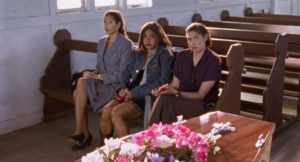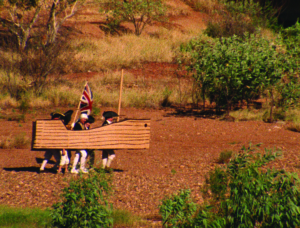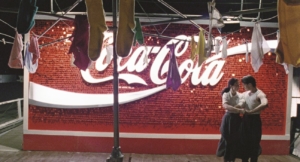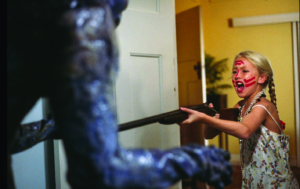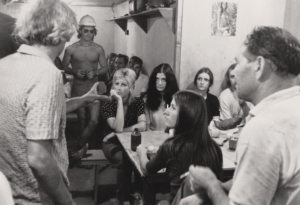Production history and background
According to Bruce Beresford, Henry Handel Richardson’s 1910 novel, The Getting of Wisdom, had long been in his imagination as a film he would like to make and direct.[1]See, for example, David Stratton, The Last New Wave, Angus & Robertson, Sydney, 1980, pp. 49–50, and Peter Coleman, Bruce Beresford: Instincts of the Heart, Angus & Robertson, Pymble, NSW, 1992, pp. 105–107, for a description of Beresford’s early interest in the novel and the hurdles of production he faced in order to make the film. As he put it to Peter Coleman, as a young man Beresford
‘thought it wonderful that a heroine could be aggressive and often nasty and cheat and lie her way to success … The people around her, the conforming Australians I knew so well, seemed to me to deserve defeat.’ He could already see a film in the ordeal of Laura Rambotham.[2]Bruce Beresford, as cited in Coleman, op. cit., p. 106.
However, the passage from his youthful fascination with the novel through to directing the film adaptation proved to be a protracted one, and saw Beresford himself make very different kinds of films – most notably and notoriously The Adventures of Barry McKenzie (1972), Barry McKenzie Holds His Own (1974) and Don’s Party (1976), which examined a very masculinised and ocker element of Australian culture. It wasn’t until the mid 1970s – when Australian cinema was flourishing due to the establishment of the Australian Film Commission (AFC) in 1975, the opening of the Film and Television School (now the Australian Film, Television and Radio School) in 1973, and the generous support of the Whitlam Labor government for the arts in general and film in particular – that Beresford, in conjunction with Phillip Adams as producer, was able to return to Richardson’s novel.
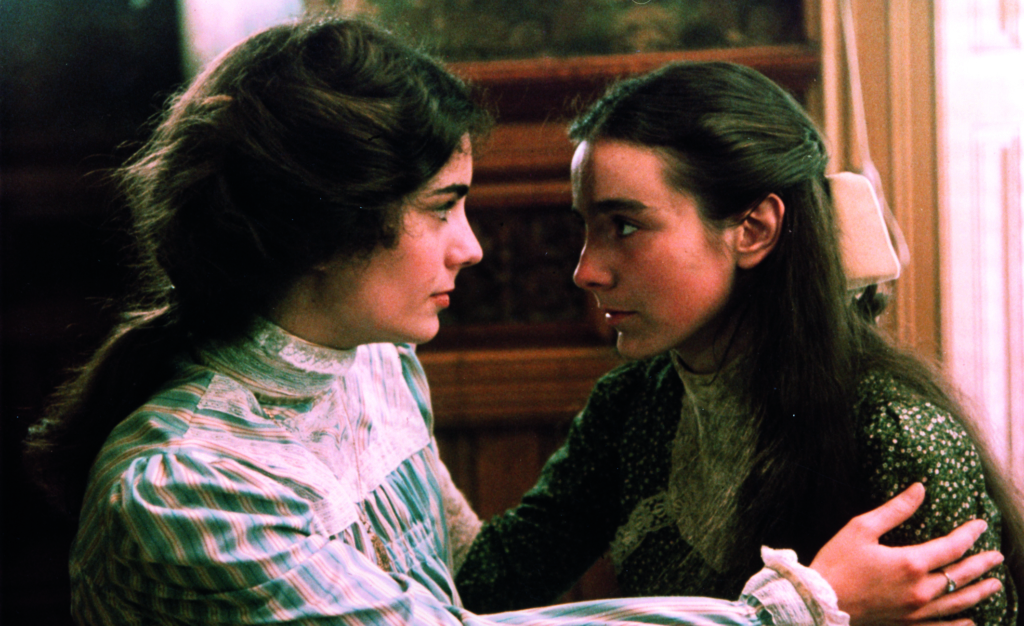
Putting the finance together for the project was not straightforward; David Stratton has noted that after the Barry McKenzie films, ‘many potential investors felt [that Beresford] was incapable of directing a sophisticated comedy of manners filled with tart social observations.’[3]Stratton, The Last New Wave, op. cit., p. 50. However, the choice of Eleanor Witcombe as screenwriter, whose work Beresford had admired in the serialisation of Seven Little Australians,[4]Coleman, op. cit., p. 107. perhaps helped to address some of the gender issues inherent in telling a young woman’s story and, as Beresford wryly notes, improved ‘my rating in the Sensitivity Stakes’.[5]ibid. Finally, Adams’ acumen in seeking out private funders, combined with significant support from the AFC and the Victorian Film Corporation, accrued the nearly $600,000 budget and saw the project become a reality. It was filmed on location in Melbourne, using the Methodist Ladies’ College as the school’s exterior, Mandeville Hall for the interiors of the school, and the town of Eddington in north Victoria as Laura’s bush home. As Adams put it upon the film’s release, ‘Thanks to the magnificent 19th century buildings and homes that have survived in Victoria … Wisdom needed no sets’,[6]Phillip Adams, ‘Henry Handel Richardson Comes to Life’, The Age, 17 August 1977, p. 8. thus further reducing budgetary requirements. The film was finally released in 1977, produced by Adams and distributed by Roadshow, and had a major release across Australia.
Peter Coleman comments that at least some of Beresford’s films might be seen as a celebration of a generic spirit of independence linked with a notion of Australianness, but he also draws attention to what he describes as the director’s ‘feminist films’ – The Getting of Wisdom, Puberty Blues (1981) and The Fringe Dwellers (1986)–and their (at the time) radical political focus, which explicitly makes the stories and experiences of strong, interesting women a central focus. While these films ‘follow the struggle of the heroines to overcome the stultifying pressures of family, school and community’, the individual’s triumphs are nevertheless seen to come at high cost. For example, ‘Laura’s success is dependent on her learning to cheat and deceive.’[7]Coleman, op. cit., p. 105. For a feisty individual like Laura, the path to success is shown to be difficult, costly and likely to be fraught with ambivalence and compromise.
Her struggle to find and be true to herself and to her nascent artistic temperament, in the face of pressure to fit in with the values of her elitist private boarding school, can be seen both as a story about the individual resisting conformity and as a narrative that pits an emergent Australian culture against the dominance of its British inheritance.
In The Getting of Wisdom, Laura is marked as an individual and an outsider because she is female, clever and from a lower social class than her schoolmates. Her struggle to find and be true to herself and to her nascent artistic temperament, in the face of pressure to fit in with the values of her elitist private boarding school, can be seen both as a story about the individual resisting conformity and as a narrative that pits an emergent Australian culture against the dominance of its British inheritance. These strands of conflict, where heritage and lineage battle independence, maturation, and a fundamental appreciation of the individual and Australianness over an Anglicised society and all the colonial, cultural cringe that went with it, characterised much of Australian film’s preoccupation at the time. This tension would also continue in Beresford’s work, which often dealt with characters on the edge of social acceptance and constraint: the young girls struggling on the edge of the ‘cool’ group in Puberty Blues, the rebels defying imperial control in Breaker Morant (1980), the marginalised Indigenous characters in The Fringe Dwellers, the pressures of class, race, gender and age in Driving Miss Daisy (1989), or even the young dancer valuing his personal feelings over the dictates of a communist state in Mao’s Last Dancer (2009).
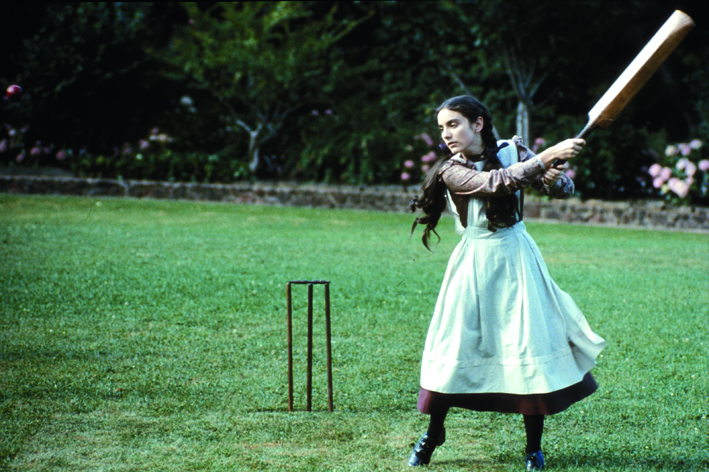
The film adaptation of The Getting of Wisdom was thus situated within a context of an emerging Australian nationalism – a reinvigorated film industry that allowed filmmakers to reflect on the history, experience and ‘identities’ of Australianness – as well as an era of second-wave feminism that sought to make central the hitherto marginalised stories of women’s lives. It was directed by one of the industry’s rising stars, and boasted performances from some well-known actors of stage and screen (Barry Humphries in a surprisingly ‘straight’ role, John Waters, Patricia Kennedy, Candy Raymond, Monica Maughan, Terence Donovan, Julia Blake, Sheila Helpmann) as well as a number of newcomers (Susannah Fowle, Kerry Armstrong, Sigrid Thornton, Hilary Ryan), some of whom went on to establish significant film careers. With the combination of experienced and inexperienced actors, Beresford was able to recreate some of the dynamics of the school itself, and foreshadow the film’s pivotal movement from the girls’ initial awkwardness and uncertainty to their emergence as socially competent young adults.
The film
The Getting of Wisdom is the story of a bright and quirky girl, Laura Tweedle Rambotham (Susannah Fowle), whose widowed mother (Kay Eklund) sends her from her home in the country to attend a prestigious boarding school in Melbourne. The film opens with Laura, positioned visually in the context of the Australian bush, telling fanciful stories to her adoring younger sister Pin (Karen Sutton), thereby demonstrating her familiarity with Victorian literature as well as a colourful and energetic imagination. As with LM Montgomery’s character of Anne in the 1908 novel Anne of Green Gables, Laura is shown right from the beginning to have a wonderfully engaging, if as yet undisciplined, imagination and love of learning, and especially of reading. As is the case with Anne, this will become her great asset and one of the attributes that distinguishes her from the group, both positively and negatively, and allows her to resist society’s expectations.
She is not able to belong in the school’s elite culture, nor is she any longer comfortable with the situation and ethos of her home; set adrift between worlds, Laura is shaped by the very culture of the school that she increasingly rails against.
From the time Laura arrives at school, festooned in the garish dress that her mother has made for her, she is marked as different and socially inferior to her classmates, the daughters of Australia’s wealthy quasi-aristocracy. In a desperate quest to fit in, Laura unsuccessfully tries a number of approaches: honesty; conspicuous effort; obsequiousness; the rejection of another girl, Chinky (Alix Longman) who, like her, comes from a less elevated class position; and even lies and deception. Aided by Chinky, Laura spins a complicated story about her supposed romance with the new school chaplain, Reverend Shepherd (John Waters), only to be exposed and further humiliated. During this period of her schooling, we also see Laura grow increasingly estranged from her home, her beloved mother and her sister. She is not able to belong in the school’s elite culture, nor is she any longer comfortable with the situation and ethos of her home; set adrift between worlds, Laura is shaped by the very culture of the school that she increasingly rails against. In her later years of school, she develops an intense friendship with an older girl, Evelyn (Hilary Ryan), and their exclusive relationship for a time eases Laura’s ongoing sense of herself as misfit, before Evelyn, suffocated by Laura’s affections, leaves the school to marry. The passionate nature of their friendship is emblematised by their shared loved of music, and Laura consequently emerges as a pianist who, as the music teacher puts it, now ‘plays with her heart as well as her head’. Distracted by the tumult of her emotions, however, Laura has to scramble to do well at her final exams, and even resorts to cheating to pass her history paper. She is awarded the prestigious music scholarship to study in Leipzig, and finishes her time at the school on a note of success, almost in spite of her stubborn individuality. The concluding scenes show Laura taking off her irksome hat and gloves, leaving her mother and sister behind at the school gateway, and running freely and determinedly through the park and into the distance.
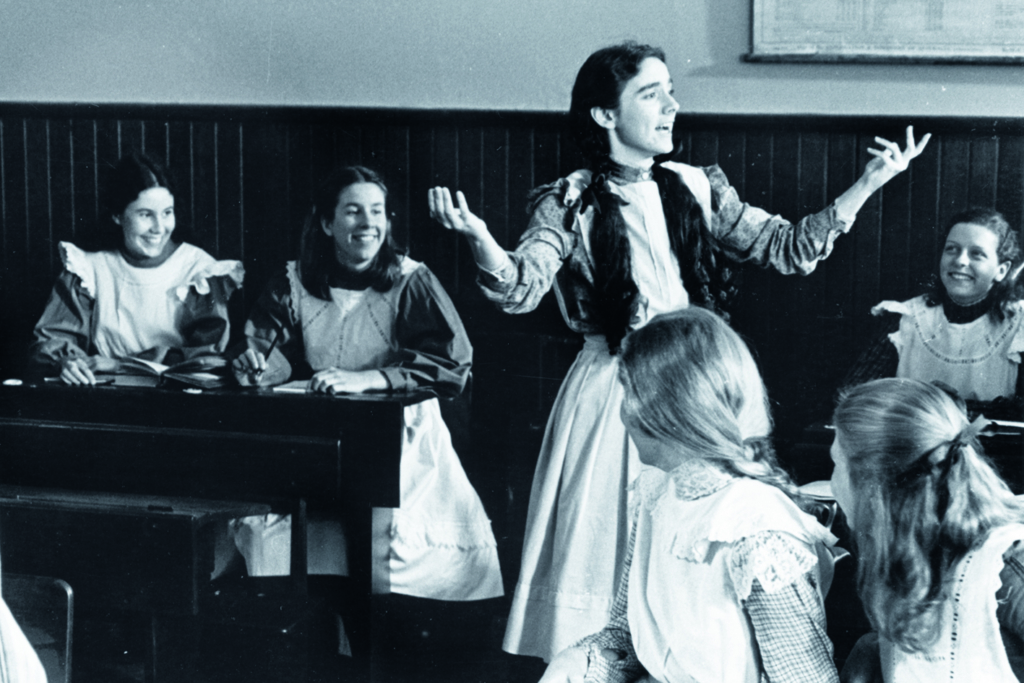
The Getting of Wisdom is one of the classic films of the Australian revival or new wave of the 1970s – that exuberant and diverse cluster of films that reflected both a climate of political support for an emerging Australian film industry, and a concomitant interest in an Australian culture and identity that could at last be differentiated from its largely Anglo-European heritage. This interest in Australian culture and experience as a category in its own right resulted in a number of films that look back into that history, often explicitly examining the fundamentally ambivalent relationship between Australia as an emergent or adolescent culture and the imperial influences of Britain in particular and Europe in general, which could be seen concomitantly as both oppressive and nurturing. In this context of emergence, a number of these films engaged both with moments in Australian history and also with narratives of individual maturation. Peter Weir’s Picnic at Hanging Rock (1975), like The Getting of Wisdom, is a story of youthful transitions – or perhaps an anxiety about a failure to transition – where romantically and sometimes erotically filmed schoolgirls are almost directly equated with the simultaneously frightening and seductive mysteries of the Australian bush; Gillian Armstrong’s My Brilliant Career (1979) adapts Miles Franklin’s famous autobiographical novel about a rebellious girl who grows into a writer, and who must overcome the stereotypes of femininity to pursue her own talents; Weir’s Gallipoli (1981) explicates the parallel between a young man’s rite of passage into adulthood and the tension involved in Australia’s narrative of separation from British culture and expectations. As Neil Rattigan describes it,
The theme of growing up (the getting of wisdom) … culminated in Gallipoli, in which the metaphoric equation between the coming to maturity of the characters of the fiction and the coming to maturity of Australia as a nation and as a culture was finally and conclusively demonstrated.[8]Neil Rattigan, Images of Australia: 100 Films of the New Australian Cinema, Southern Methodist University Press, 1991, p. 139. See also my discussion of the film, which discusses this transition in the terms of a dominant masculinity: Rose Lucas ‘The Gendered Battlefield: Sex and Death in Gallipoli’, in Joy Damousi & Marilyn Lake (eds), Gender and War, Cambridge University Press, 1995, pp. 148–61.
The Mango Tree (Kevin Dobson, 1977), The Devil’s Playground (Fred Schepisi, 1976) and The Chant of Jimmie Blacksmith (Fred Schepisi, 1978) also engage in the activity of looking back and reconsidering Australian history while, as film narrative usually has it, refracting this through a particular story.
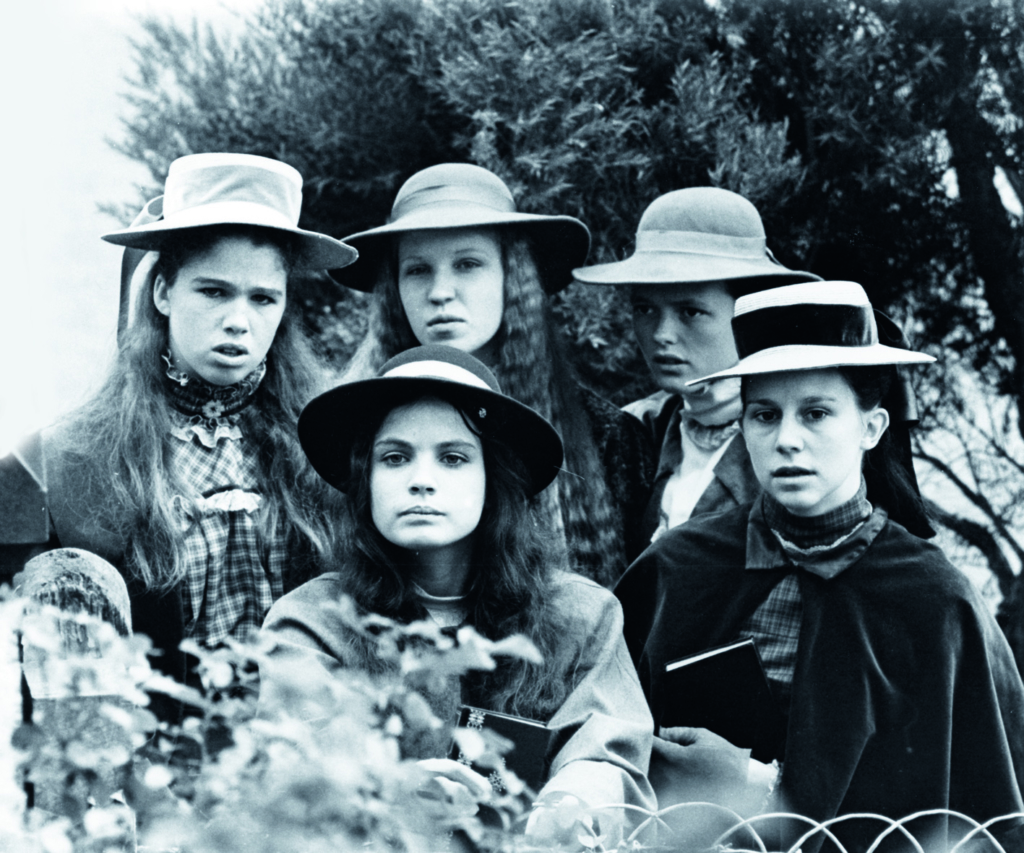
In addition to being a period drama in an era of many historically situated films, The Getting of Wisdom is also the adaptation of one of the classic works of Australian literature. Published in 1910 by Ethel (Etta) Florence Lindesay Richardson under the pen-name of Henry Handel Richardson, the novel closely chronicles Richardson’s own experience from ages thirteen to seventeen as a boarder at the elite Presbyterian Girls College in Melbourne. Like Laura, her family had fallen on hard times following the death of her father and his chaotic legacy of erratic behaviour and gambling debts.[9]Richardson tells this story of the rise and fall of her father in the novel The Fortunes of Richard Mahoney, William Heinemann, 1930. Her no doubt desperate and enterprising widowed mother supported the family by running the post office in Maldon. To send the bright young Ethel off to college in the city would certainly have been both a financial impost and a loss to the family, but it was clearly also a strategy to not only educate a girl with potential, but also restore her – and perhaps through her, the family – to a more elevated position in society. Richardson’s novel is far more than a reminiscence about school days; with sharpness and irony it explores that fundamental tension between an education which might be of intellectual and personal benefit for a student and one which might primarily be a gateway to social advantage and the reinforcement of elitist values.
This wisdom that Laura is seen to go about getting, then, is in fact the pragmatic knowledge of how to survive in a fundamentally competitive and elitist social environment, where success is not necessarily based in merit or honesty.
The novel uses as an epigraph a quote from the Book of Proverbs: ‘Wisdom is the principal thing; therefore get wisdom: and with all thy getting get understanding’. In the film, these lines are given to Evelyn to read out in church. The question of what might actually constitute this ‘wisdom’ is indeed the novel’s central irony. As Brian McFarlane notes, although the concept of wisdom is couched in the language of religion and conformity, the events of both the novel and film would seem to suggest something quite different. In fact,
[Laura] learns that an instinctive honesty of response is a dangerous attribute; to be wholly yourself is apt to make you disagreeable to others and a trial to yourself; to learn to cope with the world is found to be largely a matter of learning to deceive others.[10]Brian McFarlane, Words and Images: Australian Novels into Film, Heinemann, Richmond, 1983, p. 58.
This wisdom that Laura is seen to go about getting, then, is in fact the pragmatic knowledge of how to survive in a fundamentally competitive and elitist social environment, where success is not necessarily based in merit or honesty. Such wisdom may be gained, and individuals may certainly benefit from it. However, as both the novel and the film suggest, it has highly problematic and disturbing elements, and must therefore call into critique any social system or set of values based upon it. If Laura succeeds in acquiring this wisdom, it is perhaps at the expense of her initial honesty, enthusiasm and playful imagination. This perspective makes The Getting of Wisdom a far more problematic narrative about maturation and success – and certainly no simple celebration of growing up or of the values of ‘Australianness’.
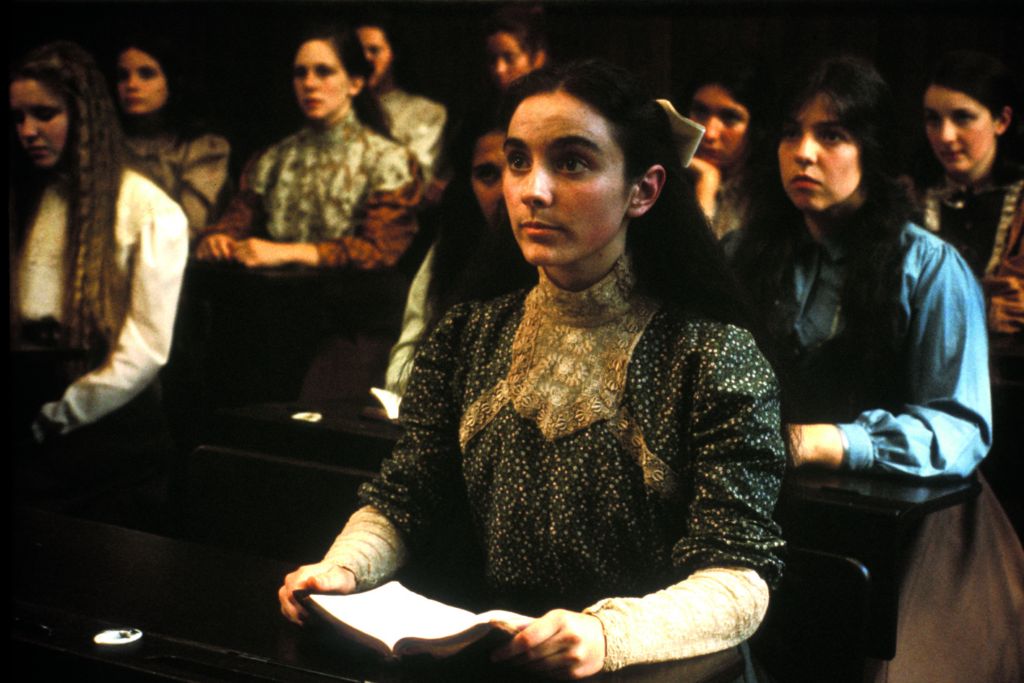
In choosing to adapt an important Australian novel, Beresford is of course riding on the coat-tails of an established art form. Looking back at the list of films of the revival, there are a number of adaptations from significant novels, as McFarlane has outlined in his book Words and Images: Australian Novels into Film. In many senses, this tendency towards literary adaptation might itself be seen as a kind of cultural cringe, where the comparatively newer art form of the cinema hopes to borrow a cultural respectability from its literary antecedent. Perhaps, in the environment of tumultuous change that predominated during the 1960s and 1970s – as ties with England became weaker and the arrival of new migrants began a process of multiculturalism; as a new alliance with the United States was heavily criticised amid the debacle of the war in Vietnam; as Australian society found a licence to critique itself and its allegiances to old ways; and in the heady atmosphere of change and experimentation that accompanied the first Labor government of the post-Menzies era – Australian film inevitably looked both ways, both embracing critique and wanting the legitimacy that literature could still confer. By choosing to adapt a novel that was a staple of school syllabuses and of the emerging canon of Australian literature – albeit one which, on close examination, exposed a significant and fracturing ambivalence between colony and empire – Beresford situated his film within a cultural tradition, using that assured position to launch a new critique of the relationship between Australia and its anglicised heritage, and, by extension, between the individual and the pressures to conform.
Witcombe’s script is largely faithful to the broad outline of Richardson’s novel, although it also deviates in certain key respects. Significantly reduced in length, it also incorporates aspects of Richardson’s later novel Maurice Guest, insofar as that novel focuses upon the protagonist’s talents as a concert pianist rather than as a budding writer – a difference that in McFarlane’s estimation leaves the film potentially incoherent. In the novel, Laura’s storytelling, academic prowess and ‘fictionalising’ (or lying about her romance with Reverend Shepherd) all seem to contribute to her development as a writer – as one who must learn to chart a course between truth and imagination. But this is foregone in the film in favour of her musical development. According to McFarlane, the musical strands of development have been left unintegrated in the overall narrative of Laura’s development:
To turn Laura into a concert pianist might conceivably have worked if the film’s musical references had been more coherently organised towards Laura’s final success and what it means in her development. As it is, it tends to make chunks of the film, as well as many minor moments that seem to be pointing toward a literary orientation, appear isolated touches at best, extraneous at worst. What music means to Laura is never integral to the film; the fact/fiction dichotomy that is often hinted at easily could have been.[11]ibid., pp. 65–6.
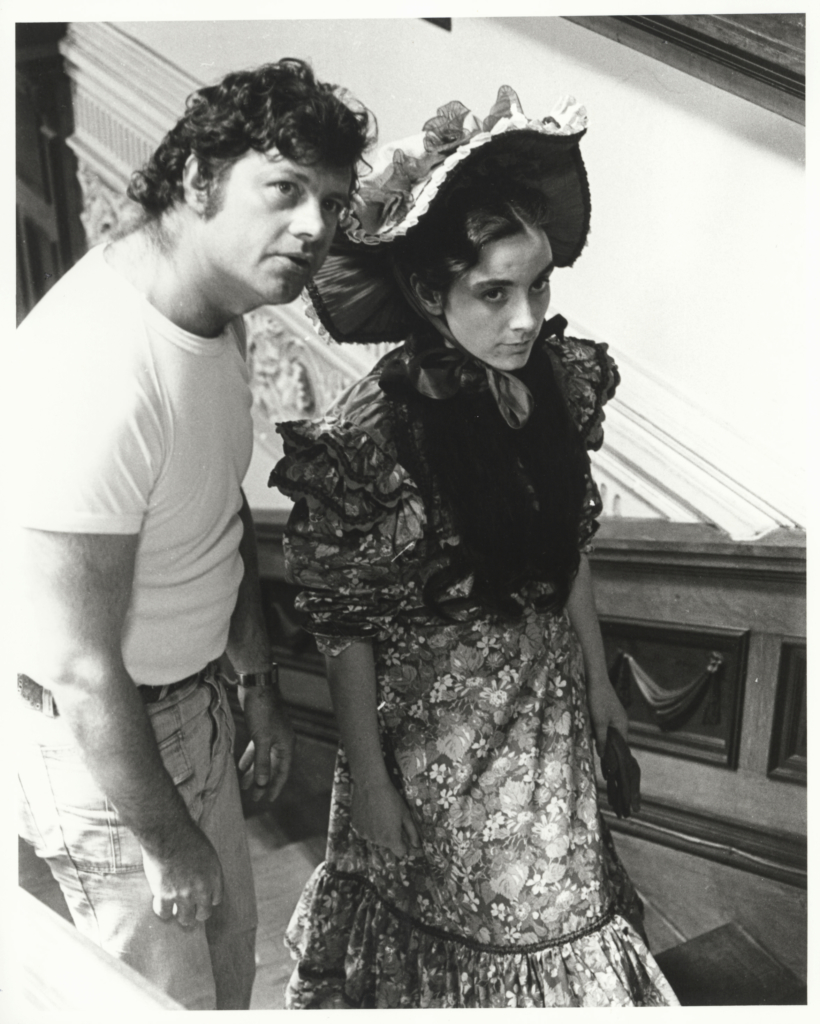
One might also add that the emergence of Laura as a writer is all the more anticipated because, based on such a well-known novel, an audience is likely to know that The Getting of Wisdom is a narrative of the author’s own school days and manifest transition into a writer – albeit also a talented pianist. However, the swerve in the middle of the film, away from Laura’s desire to become a writer and into her journey to become a concert pianist, certainly adds an element of visibility, or at least audibility, into the film’s diegesis. By Laura’s graduation, when she chooses to play the Schubert, with its personal associations with Evelyn, rather than the announced Beethoven, we see how she has grown and developed in her confidence, as well as retained an element of her stubborn individuality. Nevertheless, as McFarlane has argued, this change does create an awkwardness and knot of incoherence within the film’s narrative development. Jonathan Rayner, however, sees the film as ‘re-directing’ the novel’s underlying irony, rather than losing its thread. Referring to the growth of Laura’s relationship with Evelyn via their emotional and visceral connection over music, Rayner notes:
The paradoxical amalgamation of alienation from pupils of her own age and opposition to the school’s mind-set, with inadvertent social climbing and official support through her music and friendship with Evelyn, provide evidence of the satiric potential within Beresford’s film, which arises from the re-direction rather than the removal of the novel’s irony.[12]Jonathan Rayner, Contemporary Australian Cinema, Manchester University Press, Manchester, 2000, p. 74.
As Josephine May argues, the complex separation narrative – of individual from group, and of Australia from colonial allegiance to England – might fruitfully be told not only against a canvas of war, as in Gallipoli, but also within the institution of the school. May claims that this is particularly the case in relation to the private school, with its overt links to questions of class and to an imperial heritage. As she notes, both The Getting of Wisdom and Picnic at Hanging Rock are set in a fin de siècle era – a literal turning point in Australia’s history, especially with the approach of federation and the establishment of a national identity. In this historical context (and of course as viewed through the retrospective lens of 1970s nationalism) May argues that the institution of the private school epitomises a profound and potentially disabling ambivalence within Australian culture, both in 1910 and in 1977, towards its British inheritance – perhaps a kind of arrested adolescence which must be resolved before further growth is possible:
The schools have a strong Protestant religious aspect … [and, as such,] represent Britishness. Although [they] represent authority and act as architectures of limitation, they are portrayed in an ambivalent way. They are simultaneously terrible and beautiful.[13]Josephine May, ‘Imagining the Secondary School: The “Pictorial Turn” and Representations of the Secondary School in Two Australian Feature Films of the 1970s’, History of Education Review, vol. 35, no. 1, 2006, p. 4.
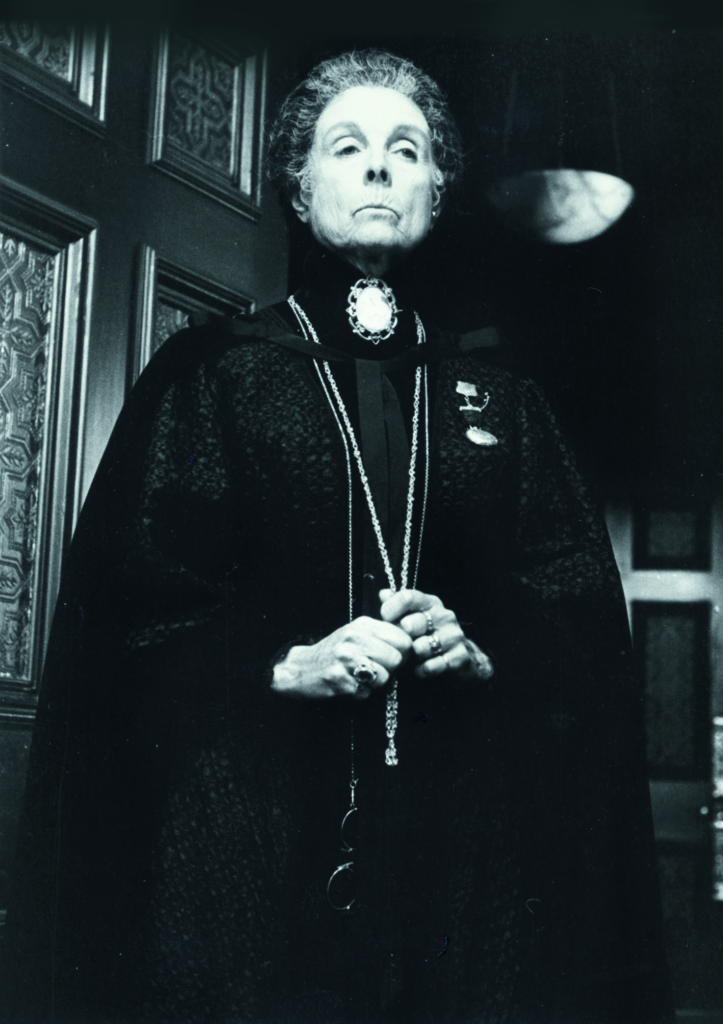
As the recent fascination with a very public scandal at Melbourne’s Methodist Ladies’ College attests,[14]On 17 September 2012, the board of MLC sacked its long-standing and well-respected principal, Rosa Storelli, eventually citing, as in divorce proceedings, ‘irreconcilable differences’. Over the next three weeks, a very public quarrel was played out; the fact that MLC was on the front page of The Age for nearly two weeks is indicative of the fascination felt by the Melbourne public for an elite school (as well as for a riveting dramatisation of the mechanisms of power). Was this an example of the uber-elite turning cannibalistically upon one of their own? Or was Storelli an individual victimised by the hierarchies of the conservative institution she thought she was serving? the private school occupies an anomalous position within Australian society. On the one hand, it is associated with the kind of elitism and class privilege that comes from an imperial Old World, in which position on the social ladder is unremittingly fixed; in this sense, the private school stands opposed to the democratic or ‘fair go’ attitude that has become linked to the pervasive notion of Australianness. On the other hand, the private school can ostensibly also offer the closest thing to social mobility and opportunity, catapulting students into higher class echelons and reinforcing their opportunities for economic and social success. Private school could be said to function this way for Laura, in that the poor and awkward country girl who arrives at the school is eventually transformed into someone who, with her scholarship to Europe, can reap the benefits of class and an imperial culture – whatever her personal reservations. May argues that the ambivalence implicit in the representation of the private school in a film such as The Getting of Wisdom reflects and ‘reinforces the postcolonial ambiguity toward Britain as coloniser’:
Private schools have been, and are, a driving engine of the Anglo-Protestant ascendancy and mainstay of the Australian class system. And the growth of the private system over many years suggests that many Australians want class mobility before they want a society based on egalitarian mythologies. In holding up the mirror, how could these films fail to reflect this fundamental fracture at the heart of the Australian national identity?[15]May, op. cit., p. 10.
This ambiguity is inherent in The Getting of Wisdom both thematically and visually. Beresford used exteriors of MLC and interiors of a number of schools, but mostly Mandeville Hall, to depict Laura’s school experiences – all schools still in contemporary use and still occupying a rarefied position within a Melbourne social hierarchy. The exterior shots of the school show a Victorian edifice that links the school directly to European aristocratic architecture, as a veritable stately home of learning. While the grounds tend to be freer spaces, with more light and natural variation, they are also manicured and walled; the cultivation of the wildness of the bush into a Europeanised garden setting here acts as a metaphor for the moulding of youthful femininity into a socially acceptable chaste and subdued form. The mise en scène inside the school reflects the constraints placed upon Laura, as well as the era’s aesthetic of busy, ornate design, heavy furnishings and dark colours. As we see in the afternoon soiree scene at Reverend Strachey’s (Barry Humphries) home, Laura is literally crowded in both by the girls and by the clutter of decorative effects; when she walks decisively and enthusiastically to the piano and plays an emotionally excessive rendition of Sigismond Thalberg’s ‘Variations on “Home Sweet Home”’, she disrupts both the expectations of decorum for proper young ladies and the particular order of the drawing room. Similarly, in the dormitories and corridors of the school, Laura is seen to be entrapped, caught in claustrophobic mazes of expectation which continually threaten to overwhelm her sense of individuality and enterprise. Only in the piano room with Evelyn do we see Laura in an environment that is light-filled and spacious, and conducive to her talents and aspirations.
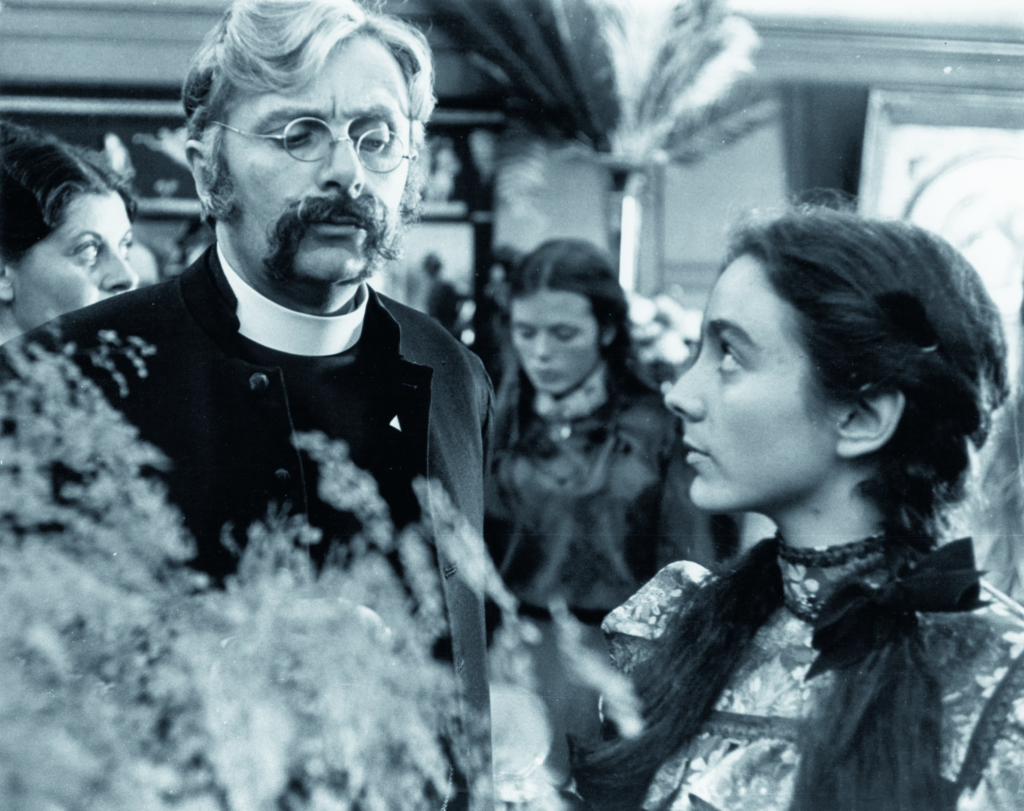
While the school would certainly seem to bring Laura opportunities, its values, and metaphorically its architecture, constrain and oppress her. Although the school, combined with Laura’s talents, provides her ‘ticket out’ – paradoxically out of the school and into European society – it also exacts a considerable price in terms of the contaminating ‘wisdom’ it gives her. The extent to which she might extend such wisdom to include a greater perspective on herself and her role within the social structure that the school represents is perhaps the prevailing question that the film leaves us with.
A number of critics have noted the ways in which Beresford’s film is episodic, sometimes to the point of feeling fractured, and without a cohering centre. For instance, John Paul Ward writes that the film’s ‘main fault’ is that ‘it can’t decide what kind of film it wants to be. Because of this The Getting of Wisdom loses its focus and becomes too episodic.’[16]John Paul Ward, ‘The Getting of Wisdom’, Films in Review, vol. 31, no. 8, October 1980, p. 501. In a review in Cinema Papers, McFarlane asserts that he finds the film ‘inadequate’ because it ‘trades the book’s controlling ironic concern for its heroine for a purely episodic treatment’.[17]Brian McFarlane, ‘The Getting of Wisdom’, Cinema Papers, no. 14, October 1977, p. 175. The film’s tendency towards the episodic is perhaps in part due both to the relentlessly chronological aspect of the narrative, and to the surprising detour from Laura’s development as a writer to her development as a concert pianist. As McFarlane has argued, this creates a difficulty within the smooth progression of the film narrative. However, it might also be claimed that any bildungsroman (or narrative of the progression of the individual), and by extension the künstlerroman (narrative of the progression of the artist), will have an episodic structure, as the narrative detail accretes in a linear manner in order to indicate emblematically such chronological change and development. Because Beresford’s film (like Richardson’s novel before it) must necessarily select episodes designed to show and imply stages and transitions in a character’s passage to maturity or achievement, there is always a sense that the juxtaposition of scenes works to explicate a movement to a final state or narrative culmination. While the bildungsroman, and perhaps particularly the rite-of-passage narrative of a young person’s individual maturation, is thus linear (rather than the more concentric nature of a drama focused on more than one character), it does also need to retain enough cohering thematic concerns and images to make explicable and plausible the film’s point of arrival. One important cohering element is of course the character of Laura herself, played with such spirit and intelligence by newcomer Susannah Fowle. Capturing much of Richardson’s reputed quirkiness and independence of spirit, Fowle brings us a Laura who is initially fired up by undirected energy and imagination, who collides awkwardly with the pressures of the school and the expectations of her schoolmates, who is passionate and intemperate in her relationship with Evelyn, and who learns to ‘play’ the system in order to succeed, even if it means cheating, yet who comes to ‘graduate’ out of the school and into her adult life with a sense of accomplishment, and with at least much of her individual spirit intact.
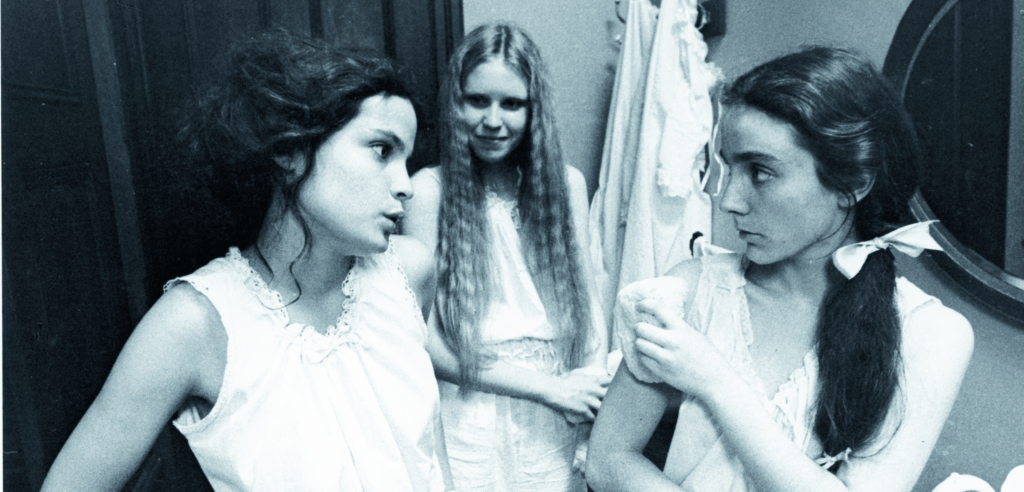
An episodic narrative will gain much of its coherence and perspective from the nature of its ‘point of arrival’, as well as through the interest generated by identification with its central character. In the graduation scene, Laura chooses to play the Schubert impromptu she has worked on intimately with Evelyn, rather than the Beethoven sonata that has won her the music scholarship. In so doing, she asserts an independence of identity – or, as Robin Wood has it, the radical assertion of an otherwise unspeakable lesbian identity – which has placed her in a profoundly ‘other’ position in relation to the social hierarchy that has just claimed and rewarded her:
The scene of Laura’s graduation and musical performance brings to the clearest focus the rich irony of the title: that in an educational system explicitly dedicated to ‘the getting of wisdom,’ the only way in which wisdom can be got is by resistance, by defining oneself in opposition to the system’s values and preserving the integrity it seeks to erode … The function of the choice she makes [to play the Schubert] is her private assertion, for herself, of her integrity and the validity of her sexual commitment.[18]Robin Wood, ‘Quo Vadis Bruce Beresford?’, in Albert Moran & Tom O’Regan (eds), An Australian Film Reader, Currency Press, Sydney, 1985, p. 201.
This moment of culminating irony could be said to go a long way towards offering an episodic narrative a point of intelligibility and coherence – although admittedly, this does rely upon a viewer paying close attention to the significance of Laura’s choice of different music.
Reception
The Getting of Wisdom was not particularly well received either by audiences or critics. As Geraldine Pascall wrote in The Sydney Morning Herald, the film had
two main problems: first, the episodic script, which probably tried to do too much and jumps quickly from one short scene or point to another; second, the irony that is such an important part of the book doesn’t quite come off in the movie.[19]Geraldine Pascall, ‘Living in the Past Maybe – But Doing It Well’, The Sydney Morning Herald, 20 August 1977.
Writing in lukewarm terms, Ward calls it ‘an appealing (yet not entirely absorbing) film’.[20]Ward, op. cit. John Pym sees the film as suffering from several ‘excesses, of both characterisation and direction’,[21]John Pym, ‘The Getting of Wisdom’, Monthly Film Bulletin, vol. 46, no. 544, May 1979, p. 96. and in relation to Laura’s development as a character, Joan Weinberg describes the ‘lack of foundation created by the script’ – in particular the lack of emphasis upon the importance of her home life and family in giving her confidence – as a ‘drastic problem’.[22]Joan Weinberg, ‘The Getting of Wisdom’, Filmnews, vol. 7, no. 9. October 1977, p. 13. Perhaps overshadowed by the success of the somewhat similar Picnic at Hanging Rock a couple of years earlier, the film grossed a modest $982,000 during its theatrical release.[23]Film Victoria, ‘Australian Films at the Australian Box Office’, 2010, <http://film.vic.gov.au/resources/documents/AA4_Aust_Box_office_report.pdf>, accessed 9 November 2012.
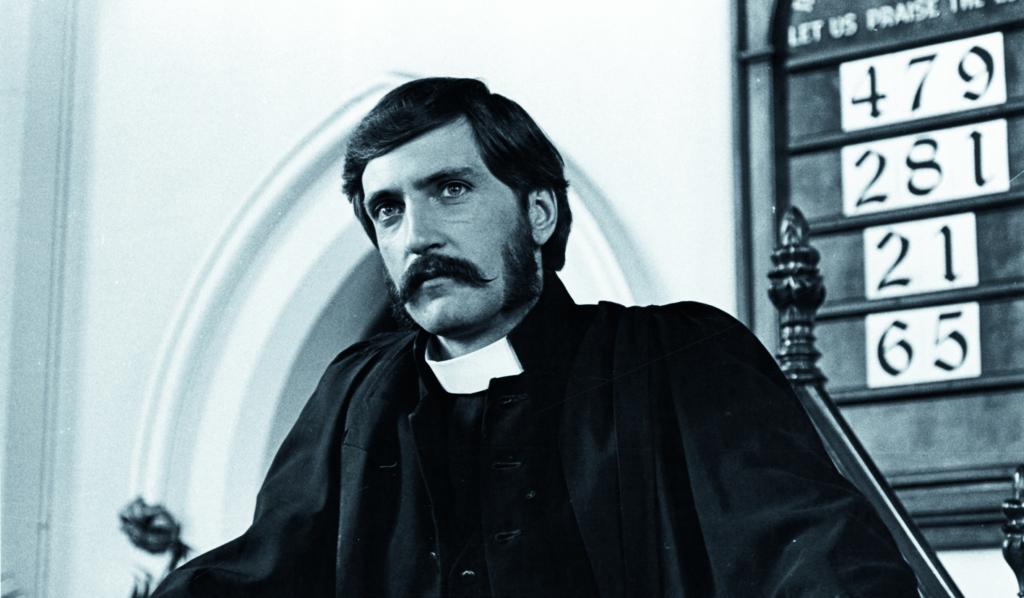
However, the film did also receive some significant recognition. It was included in the important Directors’ Fortnight showing at Cannes in 1978, where it was well received. It was also nominated for five Australian Film Institute Awards: Best Achievement in Costume Design, Production Design, Best Actress in a supporting role (Patricia Kennedy) and Best Adapted Screenplay – which Eleanor Witcombe won. Writing in 2006, Erin Free makes the point that, although underrated at the time,
The Getting of Wisdom has now achieved the respect and acclaim that it deserves. It was the first film to highlight Beresford’s sensitivity; launched a fistful of important careers; and dared to tell a definitively female story in a climate of blaring Australian machismo. Make no mistake: despite the pretty dresses, The Getting of Wisdom is one tough film.[24]Erin Free, ‘The Getting of Wisdom’, in Scott Hocking (ed.), 100 Greatest Films of Australian Cinema, Scribal, Richmond, 2006, p. 106.
The Getting of Wisdom is also a film that continues to interest scholars and viewers alike for many reasons: for its central position within the Australian film revival; its historical interest in fin de siècleAustralian society and its metaphoric relationship with an individual’s transition away from the influences of the past and towards a future of her own making; its interest in a female protagonist; its links to an important Australian novel; its important standing in Beresford’s now extensive filmography; and perhaps also because of the still-surprising strength of Susannah Fowle’s performance as Laura. The complexity and ambiguity involved in Laura’s transition through the education she receives and her ability to gain sufficient ‘wisdoms’ to both survive and even to prosper make The Getting of Wisdom an enduringly engaging narrative for Australian audiences.
Bibliography
Phillip Adams, ‘Henry Handel Richardson Comes to Life’, The Age, 17 August 1977, p. 8.
Marjorie Bilbow, ‘The Getting of Wisdom’, Screen International, no. 189, 12 May 1979, p. 17.
Peter Coleman, Bruce Beresford: Instincts of the Heart, Angus & Robertson, Pymble NSW, 1992, pp. 105–11.
Erin Free, ‘The Getting of Wisdom’, in Scott Hocking (ed.), 100 Greatest Films of Australian Cinema, Scribal, Richmond, 2006, p. 106.
Scott Hocking (ed.), 100 Greatest Films of Australian Cinema, Scribal, Richmond, 2006.
Terry Jennings, ‘Thumpings about Wisdom’, The Advertiser, 23 July 1977, p. 8.
Rose Lucas, ‘The Gendered Battlefield: Sex and Death in Gallipoli’, in Joy Damousi & Marilyn Lake (eds), Gender and War, Cambridge University Press, 1995, pp. 148–61.
Josephine May, ‘Imagining the Secondary School: The “Pictorial Turn” and Representations of Secondary Schools in Two Australian Feature Films of the 1970s’, History of Education Review, vol. 35, no. 1, 2006, pp. 13–22.
Brian McFarlane, ‘The Getting of Wisdom Review’, Cinema Papers, no. 14, October 1977, p. 175.
Brian McFarlane, Words and Images: Australian Novels into Film, Heinemann, Richmond, 1983, pp. 57–69.
Brian McFarlane, Geoff Mayer & Ina Bertrand (eds), The Oxford Companion to Australian Film, Oxford University Press, South Melbourne, 1999.
Albert Moran & Tom O’Regan (eds), An Australian Film Reader, Currency Press, Sydney, 1985.
Scott Murray (ed.), Australian Cinema, Allen & Unwin and Australian Film Commission, St Leonards, 1994.
Geraldine Pascall, ‘Living in the Past Maybe – But Doing It Well’, The Sydney Morning Herald, 20 August 1977.
Ron Pennington, ‘The Getting of Wisdom’, The Hollywood Reporter, 28 September 1978.
Andrew Pike & Ross Cooper, Australian Film 1900–1977: A Guide to Feature Film Production, Oxford University Press, South Melbourne, 1998.
Roland Pullen, ‘Australia Puts Up a Bold Front’, Adelaide Advertiser, 19 May 1978.
John Pym, ‘The Getting of Wisdom’, Monthly Film Bulletin, vol. 46, no. 544, May 1979, pp. 95–6.
Neil Rattigan, Images of Australia: 100 Films of the New Australian Cinema, Southern Methodist University Press, Dallas, 1991, pp. 139–41.
Jonathan Rayner, Contemporary Australian Cinema, Manchester University Press, Manchester, 2000.
Henry Handel Richardson, Maurice Guest, 1908.
Henry Handel Richardson, The Getting of Wisdom, 1910.
Henry Handel Richardson, The Fortunes of Richard Mahoney, 1930.
William D Routt, ‘The Getting of Wisdom’, in Brian McFarlane, Geoff Mayer & Ina Bertrand (eds), The Oxford Companion to Australian Film, Oxford University Press, South Melbourne, 1999, pp. 182–3.
David Stratton, The Last New Wave, Angus & Robertson, Sydney, 1980, pp. 49–53.
Graeme Turner, National Fictions: Literature, Film and the Construction of Australian Narrative, 2nd Edn, Allen & Unwin, St Leonards NSW, 1993, pp. 70–5.
John Paul Ward, ‘The Getting of Wisdom’, Films in Review, vol. 31, no. 8, October 1980, p. 501.
Joan Weinberg, ‘The Getting of Wisdom’, Filmnews, vol. 7, no. 9, October 1977, p. 13.
Robin Wood, ‘Quo Vadis Bruce Beresford?’, in Albert Moran & Tom O’Regan (eds), An Australian Film Reader, Currency Press, Sydney, 1985, pp. 198–203.
Principal Cast
Laura Tweedle Rambotham: Susannah Fowle
Reverend Strachey: Barry Humphries
Reverend Shepherd: John Waters
Evelyn: Hilary Ryan
Tom McNamara: Terence Donovan
Miss Chapman: Patricia Kennedy
Mrs Gurley: Sheila Helpmann
Miss Zielinski: Candy Raymond
Miss Snodgrass: Jan Friedl
Miss Day: Monica Maughan
Mrs Rambotham: Kay Eklund
MP: Celia de Burgh
Isabella Shepherd: Julia Blake
Kate: Kerry Armstrong
Lilith: Kim Deacon
Chinky: Alix Longman
Tilly: Jo-Anne Moore
Cupid: Amanda Ring
Maria: Sigrid Thornton
Pin: Karen Sutton
Principal Credits
Year of Release: 1977
Length: 98 minutes
Director: Bruce Beresford
Assistant Director: Michael Lake
Producer: Phillip Adams
Screenplay: Eleanor Witcombe (from the novel by Henry Handel Richardson)
Production Company: Southern Cross Films Pty Ltd
Distributor: Roadshow
Art Director: Richard Kent
Production Designer: John Stoddart
Production Manager: Russel Karel
Director of Photography: Donald McAlpine
Camera Operator: Gale Tattersall
Editor: William M Anderson
Costume Designer: Anna Senior
Sound: Desmond Bone, Gary Wilkins
Piano recorded by: Sarah Grunstein
Endnotes
| 1 | See, for example, David Stratton, The Last New Wave, Angus & Robertson, Sydney, 1980, pp. 49–50, and Peter Coleman, Bruce Beresford: Instincts of the Heart, Angus & Robertson, Pymble, NSW, 1992, pp. 105–107, for a description of Beresford’s early interest in the novel and the hurdles of production he faced in order to make the film. |
|---|---|
| 2 | Bruce Beresford, as cited in Coleman, op. cit., p. 106. |
| 3 | Stratton, The Last New Wave, op. cit., p. 50. |
| 4 | Coleman, op. cit., p. 107. |
| 5 | ibid. |
| 6 | Phillip Adams, ‘Henry Handel Richardson Comes to Life’, The Age, 17 August 1977, p. 8. |
| 7 | Coleman, op. cit., p. 105. |
| 8 | Neil Rattigan, Images of Australia: 100 Films of the New Australian Cinema, Southern Methodist University Press, 1991, p. 139. See also my discussion of the film, which discusses this transition in the terms of a dominant masculinity: Rose Lucas ‘The Gendered Battlefield: Sex and Death in Gallipoli’, in Joy Damousi & Marilyn Lake (eds), Gender and War, Cambridge University Press, 1995, pp. 148–61. |
| 9 | Richardson tells this story of the rise and fall of her father in the novel The Fortunes of Richard Mahoney, William Heinemann, 1930. |
| 10 | Brian McFarlane, Words and Images: Australian Novels into Film, Heinemann, Richmond, 1983, p. 58. |
| 11 | ibid., pp. 65–6. |
| 12 | Jonathan Rayner, Contemporary Australian Cinema, Manchester University Press, Manchester, 2000, p. 74. |
| 13 | Josephine May, ‘Imagining the Secondary School: The “Pictorial Turn” and Representations of the Secondary School in Two Australian Feature Films of the 1970s’, History of Education Review, vol. 35, no. 1, 2006, p. 4. |
| 14 | On 17 September 2012, the board of MLC sacked its long-standing and well-respected principal, Rosa Storelli, eventually citing, as in divorce proceedings, ‘irreconcilable differences’. Over the next three weeks, a very public quarrel was played out; the fact that MLC was on the front page of The Age for nearly two weeks is indicative of the fascination felt by the Melbourne public for an elite school (as well as for a riveting dramatisation of the mechanisms of power). Was this an example of the uber-elite turning cannibalistically upon one of their own? Or was Storelli an individual victimised by the hierarchies of the conservative institution she thought she was serving? |
| 15 | May, op. cit., p. 10. |
| 16 | John Paul Ward, ‘The Getting of Wisdom’, Films in Review, vol. 31, no. 8, October 1980, p. 501. |
| 17 | Brian McFarlane, ‘The Getting of Wisdom’, Cinema Papers, no. 14, October 1977, p. 175. |
| 18 | Robin Wood, ‘Quo Vadis Bruce Beresford?’, in Albert Moran & Tom O’Regan (eds), An Australian Film Reader, Currency Press, Sydney, 1985, p. 201. |
| 19 | Geraldine Pascall, ‘Living in the Past Maybe – But Doing It Well’, The Sydney Morning Herald, 20 August 1977. |
| 20 | Ward, op. cit. |
| 21 | John Pym, ‘The Getting of Wisdom’, Monthly Film Bulletin, vol. 46, no. 544, May 1979, p. 96. |
| 22 | Joan Weinberg, ‘The Getting of Wisdom’, Filmnews, vol. 7, no. 9. October 1977, p. 13. |
| 23 | Film Victoria, ‘Australian Films at the Australian Box Office’, 2010, <http://film.vic.gov.au/resources/documents/AA4_Aust_Box_office_report.pdf>, accessed 9 November 2012. |
| 24 | Erin Free, ‘The Getting of Wisdom’, in Scott Hocking (ed.), 100 Greatest Films of Australian Cinema, Scribal, Richmond, 2006, p. 106. |

